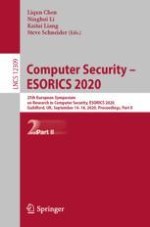2020 | OriginalPaper | Chapter
A Verifiable and Practical Lattice-Based Decryption Mix Net with External Auditing
Authors : Xavier Boyen, Thomas Haines, Johannes Müller
Published in: Computer Security – ESORICS 2020
Publisher: Springer International Publishing
Activate our intelligent search to find suitable subject content or patents.
Select sections of text to find matching patents with Artificial Intelligence. powered by
Select sections of text to find additional relevant content using AI-assisted search. powered by
